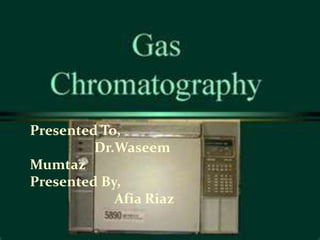
Gas chromatography 2
- 1. Presented To, Dr.Waseem Mumtaz Presented By, Afia Riaz
- 2. Gas chromatography is common type of chromatography for separating and analyzing compounds that can be vaporized without decomposition. Typical uses of GC include testing the purity of a particular substance, or separating the different components of a mixture
- 3. In gas chromatography, the mobile phase is a carrier gas, usually an inert gas such as helium or an unreactive gas such as nitroge. The stationary phase is a microscopic layer of liquid or polymer on an inert solid support, inside a piece of glas or metal tubing called a column . The instrument used to perform gas chromatography is called a gas chromatograph
- 4. Rentention Time • The gaseous compounds being analyzed interact with the walls of the column, which is coated with different stationary phases. This causes each compound to elute at a different time, known as the retention time of the compound
- 5. Column Gas Chromatography Chromatography The liquid is stationary the stationary phase is a phase and a gas is mobile phase, solid and the mobile phase the column through which is a liquid the gas phase passes is column chromatography located in an oven where the temperature of the gas can be has no such temperature controlled control The concentration of a No such condition can compound in the gas phase is solely a function of the vapor exist in it. pressure of the gas
- 7. Carrier gas Sample injection port Sample injection port Column temperature Detectors
- 8. The carrier gas must be chemically inert. Commonly used gases include nitrogen, helium, argon, and carbon dioxide. The choice of carrier gas is often dependant upon the type of detector which is used. The carrier gas system also contains a molecular sieve to remove water and other impurities.
- 9. For optimum column efficiency, the sample should not be too large, and should be introduced onto the column as a "plug" of vapour - slow injection of large samples causes band broadening and loss of resolution The most common injection method is where a microsyringe is used to inject sample through a rubber septum into a flash vapouriser port at the head of the column. The temperature of the sample port is usually about 50 C higher than the boiling point of the least volatile component of the sample. For packed columns, sample size ranges from tenths of a microliter up to 20 microliters.
- 11. There are two general types of column, packed and capillary . Packed columns contain a finely divided, inert, solid support material (commonly based on diatomaceous earth) coated with liquid stationary phase. Most packed columns are 1.5 - 10m in length and have an internal diameter of 2 - 4mm.
- 13. Capillary columns have an internal diameter of a few tenths of a millimeter. They can be one of two types; wall-coated open tubular (WCOT) or support-coated open tubular (SCOT). Wall-coated columns consist of a capillary tube whose walls are coated with liquid stationary phase.
- 14. In 1979, a new type of WCOT column was devised - the Fused Silica Open Tubular (FSOT) column; These have much thinner walls than the glass capillary columns, and are given strength by the polyimide coating. These columns are flexible and can be wound into coils. They have the advantages of physical strength, flexibility and low reactivity.
- 15. For precise work, column temperature must be controlled to within tenths of a degree. The optimum column temperature is dependant upon the boiling point of the sample. As a rule of thumb, a temperature slightly above the average boiling point of the sample results in an elution time of 2 - 30 minutes. Minimal temperatures give good resolution, but increase elution times. If a sample has a wide boiling range, then temperature programming can be useful. The column temperature is increased (either continuously or in steps) as separation proceeds.
- 16. There are many detectors which can be used in gas chromatography. Different detectors will give different types of selectivity. A non-selective detector responds to all compounds except the carrier gas, a selective detector responds to a range of compounds with a common physical or chemical property . a specific detector responds to a single chemical compound. Detectors can also be grouped into concentration dependant detectors and mass flow dependant detectors. The signal from a concentration dependant detector is related to the concentration of solute in the detector, and does not usually destroy the sample Dilution of with make-up gas will lower the detectors response.
- 18. The effluent from the column is mixed with hydrogen and air, and ignited. Organic compounds burning in the flame produce ions and electrons which can conduct electricity through the flame. A large electrical potential is applied at the burner tip, and a collector electrode is located above the flame. The current resulting from the pyrolysis of any organic compounds is measured
- 19. In general, substances that vaporize below ca. 300 °C (and therefore are stable up to that temperature) can be measured quantitatively. in assuring the quality of products in the chemical industry; or measuring toxic substances in soil, air or water. GC is very accurate if used properly and can measure picomoles of a substance in a 1 ml liquid sample, or parts-per-billion concentrations in gaseous sample The hydrocarbons are separated using a capillary column and detected with an FIDs.
- 20. avia, Donald L., Gary M. Lampman, George S. Kritz, Randall G. Engel (2006). Introduction to Organic Laboratory Techniques (4th Ed.). Thomson Brooks/Cole. pp. 797–817. ISBN 978-0- 495-28069-9. ^ "Gas Chromatography". Linde AG. Retrieved 11 March 2012. ^ "Gas Chromatography". ACRF. Retrieved 11 March 2012. http://www.cma.be/LinkClick.aspx?fileticket=360tG4 4CHsQ%3D&tabid=169&mid=739
